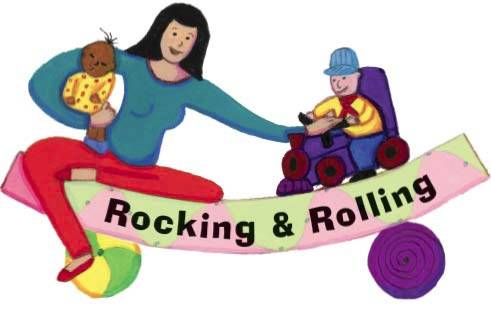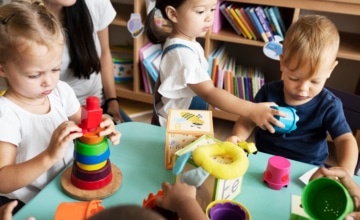The words routine and ritual are sometimes used interchangeably. Yet there are some important differences. Routines are repeated, predictable events that provide a foundation for the daily tasks in a child’s life.
Josh brings Eliana, 20 months, into the family child care provider’s home. Sherita greets Josh and Eliana with a warm “Good morning!” Eliana buries her head in her father’s shoulder. Sherita pats Eliana on the back and says, “It feels so good to snuggle with Daddy.” Josh tells Sherita how Eliana slept and what she had for breakfast. Eliana peeks at Sherita, and Sherita says, “I see you looking at me! Come, let me hold you while Daddy leaves for work. You know what to do: give him a kiss and a hug, and then we will go to the window. Watch—when Daddy gets to the car, he’s going to turn around and wave to you.” Eliana watches for her daddy to turn around and wave, then waves back.
MORNING ARRIVALS didn’t always go this smoothly for Eliana and her father. When Eliana first came to Sherita’s program, she had a very hard time letting her father leave and he had a hard time leaving. Sherita suggested that she and Josh think about a ritual to perform every morning when he left. Eliana could feel some control over this transition (or at least an understanding of her own role), and that might make it easier for both of them to say goodbye.
Josh suggested the strategy described in the vignette because it was what he and his partner did when they left Eliana at home with a babysitter. In the beginning, Eliana still cried. But over time and with patience, this daily ritual smoothed the way for parting from her dad at the family child care home.
What are routines?
The words routine and ritual are sometimes used interchangeably. Yet there are some important differences. Routines are repeated, predictable events that provide a foundation for the daily tasks in a child’s life. Teachers can create a predictable routine in early childhood settings for infants and toddlers, and they can individualize those routines to match children’s needs for sleeping and eating and to support children’s development of self-regulation. Individualizing a routine means that the sequence is the same but the actions and timing may vary to accommodate the needs of individual children.
A typical schedule for infants and toddlers consists of arrival, playtime, snack, lunch, naptime, snack, and departure, with diapering taking place when needed and diaper checks at scheduled times throughout the day. Within this schedule, individual children arrive at different times, nap for different periods, eat when hungry, and so on. But the schedule of events remains consistent, providing a basic framework for the day. The familiar pattern helps infants and toddlers know what to expect and when to expect it. However, even when routines are consistent and predictable, a ritual can ease or enhance aspects of routines to make them more manage-able and meaningful to the child and the caregiver.
What are rituals?
Rituals can be defined as special actions that help us navigate emotionally important events or transitions in our lives as well as enhance aspects of our daily routines to deepen our connections and relationships. For adults, rituals are sometimes associated with events like weddings, funerals, holidays, and religious practices. They provide a way to acknowledge the importance of such events and are usually comforting.
In early childhood settings, rituals can be developed between a parent and child or a teacher and child to ease or enrich emotionally loaded moments such as separations. A ritual is a special practice that helps a child accept aspects of a routine, even an individualized routine, that are stressful. In the opening vignette, the parting ritual that takes place within the arrival routine provides a bridge for the emotionally challenging experience of saying good-bye.
The time, predictability, and reliable emotional tone of rituals give the child, parent, and caregiver a sense of comfort and control. They help the child manage, or regulate, the unsettling feelings evoked by change and draw the child and the parent or caregiver closer with each reassuring repetition. Rituals support emotional self-regulation by offering young children a way to manage their strong emotions during a stressful time.
Because rituals are attuned to a child’s individual needs, age, and family culture, they are developmentally appropriate. Each ritual is an individual set of practices for a particular child and her family or teacher. Eliana’s ritual matches her stage of development. It would not work with a 6-month-old, whose memory would not be developed enough to hold a sequence of events in his mind.
Rituals are culturally appropriate because families help create them by sharing information about their ways of handling specific routines or emotionally challenging events. For example, a caregiver engaged in the routine of hand washing with Bobby (10 months) sings the ABC song to him, so that Bobby washes his hands for the required 30 seconds. She uses this song because it is the song Bobby’s mother uses at home. For Eric, 30 months, she sings a song about the bubbles going down the drain, a ritual they developed together to make that 30 seconds fly by. These simple rituals around hand washing help deepen her relationship with each child and make even the mundane meaningful for both child and adult.
Rituals are not just about making transitions easier for an infant; they are also about helping the special adults in the infant’s life. Donald Winnicott, a pediatrician and renowned psychiatrist, stated, “There is no such thing as a baby… [there is] a baby and someone. A baby cannot exist alone, but is essentially part of a relationship.” (1964/1987, 88).
Rituals can provide support to that important someone in a child’s life. Josh felt respected when Sherita enlisted his support in easing Eliana’s transitions into her care, taking into consideration his experiences and practices. Rituals, when created by parent, child, and teacher together, respect each person’s feelings. Therefore, they support the goal of creating and deepening the strong connections between parents and their children as well as between parents and their children’s teachers. Over time, the morning parting ritual may change as Eliana adjusts to Sherita’s family child care program and develops new ways to meet her need for security and control. This ritual will have provided a stepping stone toward her new understanding.
Rituals are intentional ways of approaching a routine, with careful consideration of the needs of the individual within the routine. For early childhood professionals, they are a way to connect on a deeper level with families and their children. Rituals and routines work together to create secure environments that nurture relationships between infants and their caregivers. They strengthen the bond between parents and child as well as create a partnership between parents and their child’s teacher.
THINK ABOUT IT.
- What role do you see rituals playing in your life?
- What is a ritual that has been particularly helpful to you? Why?
TRY IT.
- Think about the children in your care. In what ways do you support their transitions throughout the day?
- Talk with families about the rituals they practice at home. Bath time and bedtime may be routine until a young child suddenly worries about the dark or about going down the drain. At that point, the adult might use a special ritual to help the child manage his fears.
Reference
Winnicott, D.W. 1964/1987. The Child, the Family, and the Outside World. New York: Perseus.
Copyright © 2012 by the National Association for the Education of Young Children. See Permissions and Reprints online at www.naeyc.org/yc/permissions.



